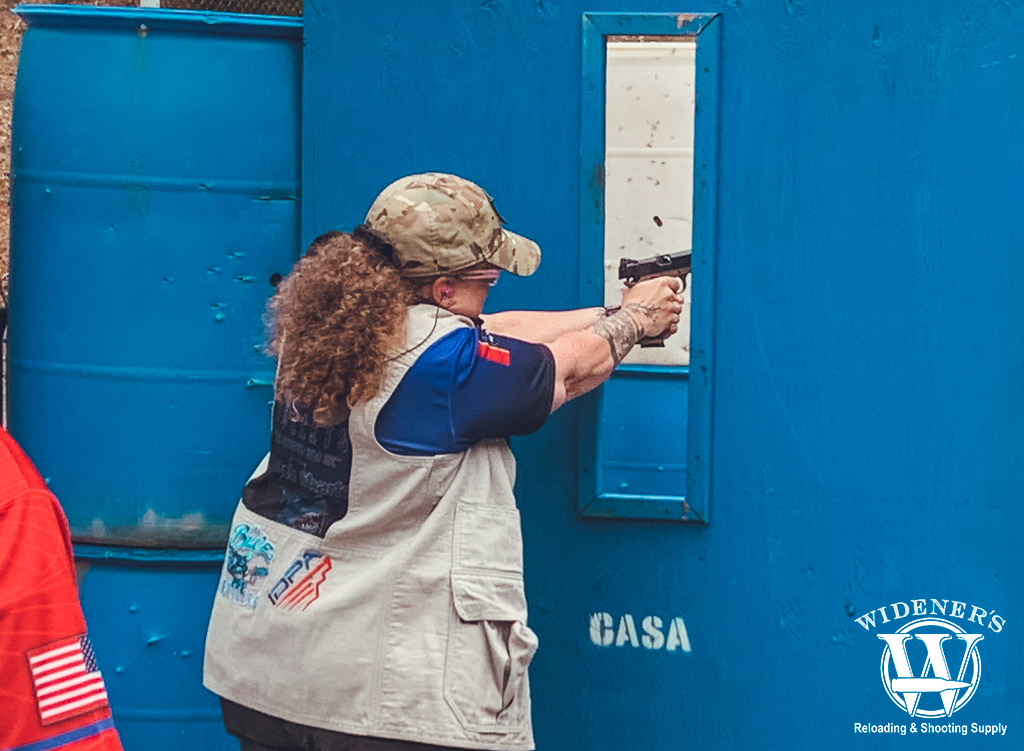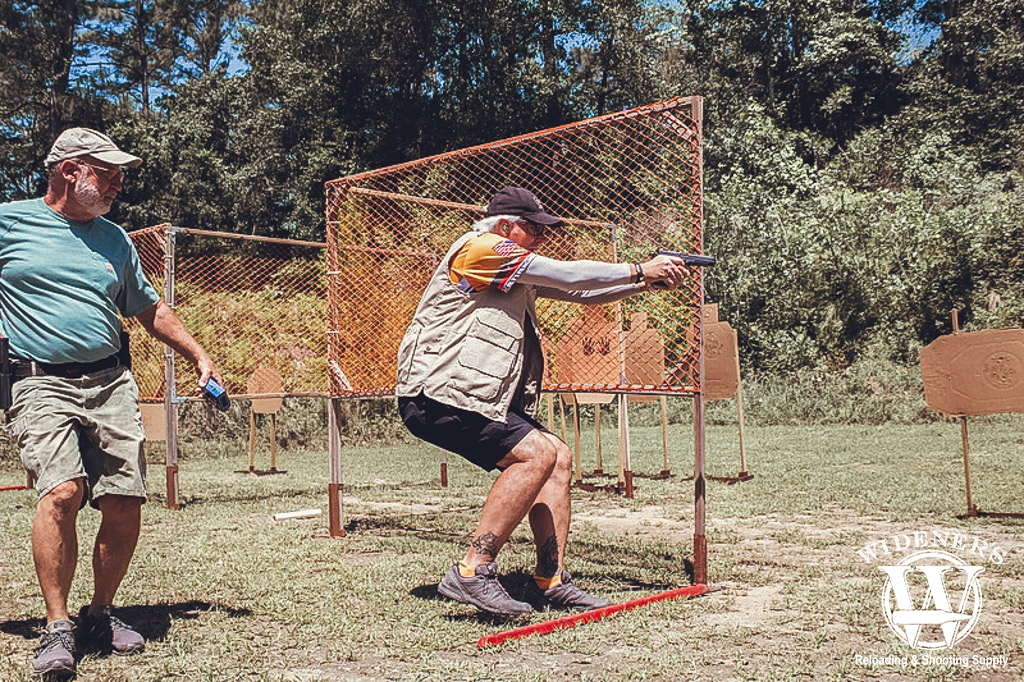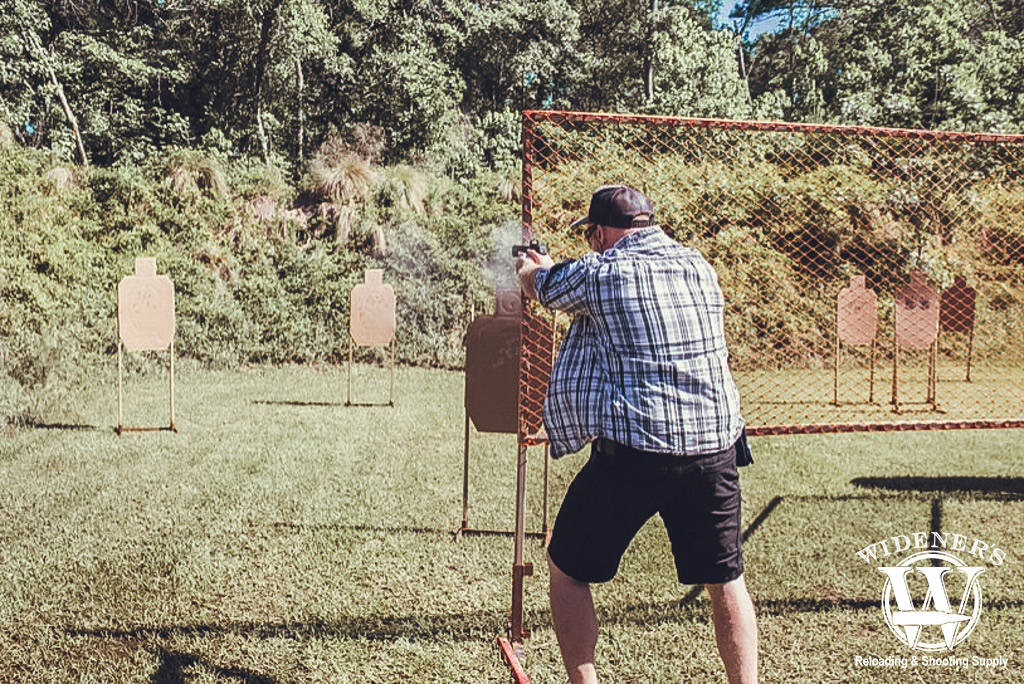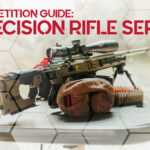

Guest Writer: Kenzie Fitzpatrick
Whether you want to get into competitive shooting sports or just improve with your concealed carry gun, the International Defensive Pistol Association is for you. Founded in 1996, IDPA is a fairly new organization that allows shooters to draw from concealment, reload under pressure, and focus on accurate shots at threat targets. Whether you carry a compact pistol, revolver, or a higher capacity custom gun, IDPA shooting has a division you can compete in.
The goal is simple for competing in IDPA. The shooter with the lowest time wins, it sounds easy but inaccuracy can lead to added time. That added time moves you further down in the final scores. Unlike other competitions, when you “score” a point in IDPA, it’s not a good thing. Each point incurred results in a second added to your time.
Targets are identified as threat and non-threat targets. Threat targets have specific zones you need to hit to neutralize a threat without gaining those penalty points. Plus, there are a few other actions that can add points to your score and bring you down further. Common mistakes include shooting outside of the fault lines or not retrieving a loaded dropped mag prior to finishing the stage. These challenges make IDPA shooting a challenge for competitors at all skill levels.
IDPA Shooting Rules

Scoring points in an IDPA match isn’t a good thing, each point adds an additional second of time to your final score.
Whether you’ve seen an IDPA match in action or not, it’s always a good idea to read the rulebook at least once. Once you figure out what division you want to compete in make sure the gun you plan to use is legal. When in doubt, open up the division rules to read more about what modifications are and are not allowed.
Per IDPA gun rules, pistols are set into specific test boxes per division with the largest magazine inserted. If the gun doesn’t fit, it does not comply with the division rules. Similarly, divisions have weight restrictions set for a maximum amount to include the gun and the heaviest magazine inserted. Even an ounce over can make your gun illegal to compete with.
Best Place To Find Out Where Local Matches Are?
Practiscore is the mecca of competitive shooting. It’s where competitors can search to find a local match, register for matches, or view their scores from previous matches. They can also go back to look through all the matches they’ve shot since opening their Practiscore account. It’s always free to use. Visit the matches tab and type in IDPA to find matches not just near you, but across the country as well.
6 Regular IDPA Divisions You Can Compete In:
Stock Service Pistol (SSP)
Your stock service pistol division is any gun that has a minimum annual production of 2,000 units (discontinued models with a total production of 20,000 units). This division requires the use of a semi-automatic pistol, double action, double action only, or striker-fired. It is limited to a capacity of 10 rounds 9mm or larger. The SSP gun test box is 8 ¾” x 6” x 1 5/8” and the maximum weight is 43.00 oz. or less unloaded, with the heaviest magazine inserted.
The most common pistol models that fit in this division are the Glock 17, 19, and 34, Smith and Wesson M&P Pro, Springfield XDM, CZ SP01 Shadow, and other commonly used stock handguns.
Enhanced Service Pistol (ESP)
The ESP division is more common than the other divisions. The only requirements are that the gun is semi-automatic chambered in 9mm or larger, with a division capacity of 10 rounds. It must fit into the 8 ¾” x 6” x 1 5/8” gun test box, and weigh 43.00 oz. or less with the heaviest magazine inserted. If the stock firearm was sold as compensated or ported, it can be used if a non-compensated/ported barrel is installed.
Custom Defensive Pistol (CDP)
The custom defensive pistol division requires the use of .45 ACP cartridges. The division rules state you must use a semi-automatic. The capacity is 8 rounds, and the gun must fit into the 8 ¾” x 6” x 1 5/8” gun test box with the largest magazine inserted. The division weight limit is 43.00 oz. or less unloaded, with the heaviest magazine inserted. Similar to the ESP division, CDP pistols must use non-compensated/ported barrels. This is even if the original firearm was sold with a compensated or ported barrel.
Compact Carry Pistol (CCP)
This division is also very popular because most concealed carry pistols are designed to be compact. Shooters compete in this division most often with their carry gun of choice to get more familiar with having to use it under pressure. Pistols in CCP must be semi-automatic, be chambered in 9mm or larger, and have a barrel length of 4 3/8″ or less. The gun test box for this division measures 7 ¾” x 5 3/8” x 1 3/8”. The unloaded gun with the heaviest magazine inserted must weigh 38.00 oz. or less to be legal to compete within the CCP division.
The Glock 19 is arguably the most common, high-capacity, reliable, carry gun on the market. Both the Glock 19x and Glock 45 are two other examples that would fit this division. However, if you modify your sights and they’re too high, it can bump you out of this division. If you prefer shooting a 1911, a full-size 1911 won’t be legal, but an example of a legal one for this division is the Kimber Custom Crimson Carry II 1911 chambered in 45 ACP.
Revolver (REV)
The revolver division is divided into two subcategories of stock revolver or enhanced revolver. A stock revolver is any revolver that uses .38 special or larger cartridges with a rimmed case and is not loaded with moon clips. The enhanced revolver division uses .357 magnum or larger cartridges with rimmed or rimless cases. This division requires the use of a speed loader or full moon clip. The stock revolver has to weigh 43.00 oz. or less while the enhanced revolver can be 50.00 oz. or less. Both of these sub-category divisions are limited to 6 rounds of capacity.
Back-Up Gun (BUG)
The two sub-categories in the BUG division are semi-automatic BUG (BUG-S) and revolver BUG (BUG-R).
For semi-automatic BUG, the firearm of choice can be single action, double action, double action only, or striker-fired. The gun must be chambered in .380 ACP or larger cartridges with a barrel length of 3 1/2″ or less. The gun used in this division must fit into the 6 1/2″ x 4 5/8″ x 13/8″ gun test box with magazine inserted and not weigh more than 26 oz. The capacity limit is 6 rounds.
For revolver BUG, the revolver must use .38 or larger cartridges with a rimmed case and is not loaded with moon clips, with no use of trimmed or shortened ammo. No more than 5 rounds can be loaded into the cylinder. The unloaded firearm must weigh 26 oz. or less with a barrel length of 2 1/2″ or less and fit in the 6 1/2″ x 4 5/8″ x 1 3/8″ box.
There are also specialty divisions (SPD) as well as pistol caliber carbine (PCC) that are optional divisions for matches. These divisions are up to the match director. They allow guns that don’t fit into any of the above categories to still be able to be used in competition. The best part about having a specialty division is junior shooters with .22 rimfire firearms are eligible to use these guns in IDPA competition. Juniors can begin strings with these guns at low ready instead of forcing the use of a holster.
Similar to shooting USPSA, IDPA allows shooters to start with one additional round in the chamber if they’re competing in semi-auto divisions (except BUG-S). Each division limits how many extra loading devices (magazines, moon clips, speed loaders) you can have on your body.
What IDPA Can Teach You

Performing under pressure in an IDPA match can teach you a lot about your ability to adapt in self-defense situations.
If you’re thinking that IDPA or other shooting competitions cannot help you in self-defense scenarios, you are wrong. The very first thing IDPA can bring to light is your ability to perform under pressure. The beep of the timer can take down the most accurate of marksmen. You will be surprised at how your body responds to this pressure, even after years of shooting.
The most important lesson, in my opinion, you get from shooting IDPA is learning whether your gun and gear will perform when you need them to most. For many shooters, IDPA is where they find out their holster doesn’t retain the pistol well. Or their magazine pouches are torqued down too tight around the magazine, or any number of things. Guns break in competition, ammo doesn’t feed properly. You really learn to either trust your firearm or go home and assess what is not performing correctly. This is invaluable information and can be an eye-opening experience for people who carry a gun every day that didn’t run flawlessly in an IDPA match.
Why Accuracy Matters
In other shooting sports such as USPSA, 3 Gun, and trap and skeet competitions, accuracy is not as important or focused on. With USPSA, speed can make up for hits outside of the “A” zone. In 3 Gun, two hits anywhere on a target mean it is neutralized. In skeet and trap shooting, the spread of a shotgun allows for you to focus less on perfect aim. As long as the clay is even chipped, it counts for your score. In IDPA, you can rack up penalty points quickly. A faster time of completing the stage may not matter as much as your inaccuracy does. It forces you to aim small, miss small, and be cognizant of innocent bystanders, which brings me to my next point.
Defensive Training
In the defense of a third-party situation or even in an emergency situation, you are going to have to determine who (or what) is the threat and who is not. The amount of time you have to react in either one of these scenarios is not very long. If you injure or kill innocent bystanders, you are liable for that shot. IDPA competitions can improve your ability to assess a situation (or stage) by increasing your eye movement and the time it takes for your brain to process information.
This is crucial in high-pressure moments when seconds count and you have to make a decision fast. IDPA targets can also be set up in a way to cause a shoot-through. If there is a threat target in front of a non-threat target and the bullet hole goes through both, you are assessed the penalty for the non-threat and the credit for hitting the threat.
How often do you practice drawing from concealment and firing a live round onto a target? A surprising number of Americans have never thought about what they would do if they had to draw their gun. IDPA requires the use of concealment garments that cover your gun and gear. Under the pressure of a timer, you quickly learn how important it is to draw your gun safely out of the holster while clearing the clothing you are wearing. Then you have to make that first shot as fast and accurate as possible.
What You Need To Shoot A Match
IDPA competitions are one of the least gear-intensive shooting competitions out there. My advice is to run what you’ve got to see if you enjoy shooting IDPA. If your gun and gear work, great. If not ask around and try other people’s guns and gear before spending a bunch of money on new stuff. Depending on your division, all you need is a sturdy belt, a few magazine pouches, magazines, and a quality holster to retain your firearm in. Then toss a fishing vest on that covers it all up and you are good to go.
How Much Ammo Should I Bring With Me?
What is unique about IDPA is that no string of fire may require more than 18 rounds. That may not sound like a lot, but IDPA stages can make each of those 18 shots difficult to take. What else is unique is that IPDA matches can vary in round counts. Some match directors have decreased round counts in 2021 to accommodate the ammo scarcity, while still designing challenging stages. A good rule of thumb is to bring 250 rounds of ammo, especially if you’re new to the sport. This way, you’ll be prepared to take a few extra shots if needed and have extra ammo in case of a reshoot.
Can I Use Optics?
While Carry Optics has not gotten its own division in IDPA yet, it is legal in the Specialty divisions (SPD). Clubs and match directors have to add this optional division and publish it in all sanctioned match announcements. The division capacity for SPD follows the 10 round maximum that SSP and ESP follow. With the growth of Carry Optics in USPSA, it could be only a matter of time for IDPA to adopt a 7th regular division.
How to Shoot IDPA

When engaging targets at an IDPA match, you must engage them with tactical priority from near to far.
IDPA has rules around engaging targets. When shooting a stage, you are required to shoot targets in “tactical priority” even when they are in the open. Targets less than 2 yards from the shooter are considered an equal threat level. If several targets are visible at once, the shooter must engage them near-to-far.
Targets that are hidden by “cover” are engaged as they become visible. This tactic is called “slicing the pie” and has a practical application for those in law enforcement. There are steel reactive and activator targets in IDPA competitions. The target engagement rules can then change to allow for you to shoot at targets activated by steel if they have equal or higher tactical priority.
Ready For The Reload
When shooting an IDPA stage, there are rules around what governs a “legal” and “penalty” reload. The preferred method of a reload in IDPA is reloading your gun when there are no bullets left in your magazine or cylinder and none in the chamber. When reloading in this scenario, you are allowed to drop your empty magazine to the ground without penalty.
You will be penalized if you reload a new magazine or reload your cylinder while there is a round still in the chamber or cylinder. This is called a “speed reload” and is assessed as a procedural error penalty whether it was intentional or not. Furthermore, if you drop a magazine, speed loader, or moon clip with unfired cartridges in it, you will receive a penalty if you do not retrieve and stow the dropped item before firing your last shot. The exception to this is if you have a malfunction. During a malfunction you can drop the magazine, speed loader/moon clip, or loose ammo that caused the malfunction.
Cover And Concealment
IDPA also simulates cover and concealment. Cover is defined as a barrier between you and the targets such as walls, barrels, and barricades. If there is cover available, you must use it while shooting targets. If you are shooting targets in the open and run out of ammo, you may reload in the open or move to the next shooting position if you are done engaging those targets.
On a stage with cover or concealment, you can reload standing still or on the move only if you are not exposed to targets that are not fully engaged during the time of the reload. IDPA will also present challenges of low cover, opening doors, and shooting through windows. Similar to slicing the pie, you must shoot targets from the side of the window.
IDPA stages will use fault lines. This can help keep shooters aware of where they are in the shooting area as well as where the 180 DQ line is. Fault lines can also create the challenge of having to engage targets without being able to expose yourself to targets. If you engage a target while outside of the fault lines, you will receive a penalty. This is also similar to USPSA and Steel Challenge shooting rules.
A good skill to have is shooting one-handed, whether with your dominant or non-dominant shooting hand. The stage brief will define when you are required to shoot an IDPA stage one-handed. Similarly, a stage may limit the number of shots you are allowed to fire on a string or a stage, and any additional shots fired can result in an added penalty.
What’s The Difference Between IPSC & IDPA?
The International Practical Shooting Confederation (IPSC) was founded to establish, maintain, improve, and advance practical shooting. IPSC competitions include handgun, shotgun, rifle, mini-rifle, pistols caliber carbine, and action air. IPSC brings shooters to competitions from all across the globe and has many regions.
USPSA is the US Region of IPSC. The style of IPSC competitions is about accuracy, power, and speed. The matches are fast-paced with reactive targets, moving targets, and can include challenging obstacles.
IDPA’s main focus is making every shot accurate, but with the greatest speed possible. IPSC and USPSA both do not force shooters into specific positions where they have to engage an array in a specific order (unless written in the stage brief). IDPA puts shooters in defensive scenarios that focus on what someone may encounter in a defensive situation. They require a shooter to navigate a course differently than they would if they were shooting IPSC and USPSA where accuracy is not as important.
Getting Started In IDPA Shooting

If you’re ready to start shooting IDPA matches, plan ahead, test your gear, and remember to have fun!
Go into your first IDPA competition humble. Absorb as much information as possible and ask questions of the shooters there. Let them know you are new to the sport. I guarantee they will take you under your wing and help you out! Remember to have fun and enjoy being able to practice American freedom of owning, carrying, and shooting a firearm.


